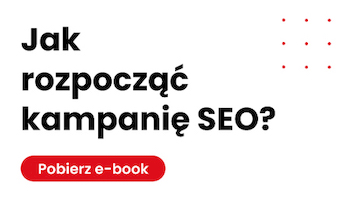Link building, or linking, i.e. obtaining links to a given domain from other, external domains, is one of the most important activities influencing building a position in free search results in Google. See what this process is and how it is used in SEO.
The original post was written in 2014, you are reading its updated version. Enjoy reading!
Spis treści
- 1 Off-page SEO, that is link building
- 2 What is link building?
- 3 PageRank – the use of links in the evaluation of websites
- 4 Links – a field for manipulation
- 5 How to build a valuable link profile?
- 6 Link building and valuable content
- 7 Certain types of links that increase the risk of receiving a penalty
- 8 Links that do not contribute to SEO
- 9 Where to get strong SEO backlinks – examples of dofollow link sources
- 10 How to check if a link is safe?
- 11 Links from the backend
- 12 Link examples
- 13 Standard and non-obvious methods of acquiring links
- 14 My presentation about link building from SEO Barcamp 2019 – Linkhouse’s 5th birthday
- 15 Links from social media
- 16 Link building vs white hat SEO
- 17 Broken links
Off-page SEO, that is link building
SEO is commonly divided into two areas:
on-page SEO – optimization activities within the website and expansion of its content,
off-page SEO – activities outside the website, mainly in the form of link acquisition.
Focusing only on one aspect limits the effectiveness of SEO, and in many industries, it even prevents effective traffic acquisition from Google. Off-page SEO discussed in this article is mainly link building. Let’s take a closer look at this process.
What is link building?
What does link building actually mean? Link building is the process of acquiring links to your website. Various techniques are used for this purpose – from automated to social engineering, which are aimed at persuading web users to link to a selected website. The vast majority of link building activities come down to the distribution of content (articles with a link inside or in the signature) in the form of guest posts, sponsored articles, etc. More budget-friendly activities include word-of-mouth marketing on forums, posting comments on blogs and other websites. From the rest of the article, you will learn how link building affects SEO and how you can acquire links.
PageRank – the use of links in the evaluation of websites
Let’s start with what links are. Links are hypertext links, i.e. links between various documents on the Internet. These are clickable elements (text, graphics, buttons) that take the user from one document (usually an HTML page) to another. The Google bot also navigates such links, i.e. connections, and thus examines the dependencies between pages and subpages on the Internet.
The role of links in SEO has been crucial practically since the inception of the Google search engine. The basis for sorting pages in search results was initially the PageRank algorithm (which is still in use, contrary to some popular opinions). When a user enters a query in the search engine, Google checks which pages in its index (i.e. in the database of pages spotted by Googlebot) are related to it. In practice, there may be hundreds of thousands of such sites. This is where PageRank comes in and sorts the found pages based on the high quality of their link profile. PageRank assigns each page a value from 1 to 10.
Are you looking for SEO services?
Let’s talk about a link building campaign that we can implement for you! If you’re interested in website optimization and SEO services, you’ll first need a professional, comprehensive audit.
Generally, the rule is quite simple – the more quality websites link to a given domain, the greater its authority. The algorithm interprets links as recommendations – many links leading to a given page are a signal that it is a resource worth recommending (and displaying in high positions to search engine users). A website with a high PageRank (the value of which we have not been able to check for specific pages for a long time) is simply easier to gain Google’s trust and appear in high positions. So you understand why acquiring links is so important.
Links – a field for manipulation
For a long time, Google was easy to fool. It was (and in some cases still is) common practice to artificially inflate PageRank values through automated, spam linking tactics. At one time, linking software such as GSA, Xrumer, or Zennoposter was used on a large scale. It is obvious that if a given effect can be achieved at a low cost, such methods are used.
However, Google is more suspicious of incoming links and is developing tools to detect prohibited behavior more effectively. Suspicious links are taught to be ignored, and in the case of overuse of spam tactics, it may even penalize the domain, lowering its visibility in search results. For example, the algorithm update released in early March 2024 also announced a new spam policy. Its goal is to eliminate unfair SEO practices, such as abusing expired domains, publishing large amounts of unoriginal content or unfairly using the reputation of websites.
Therefore, qualitative, effective link building is becoming more and more difficult and more expensive, but on the other hand – it is increasingly based on qualitative marketing activities such as:
cooperation with the media,
content marketing,
activity at industry events,
cooperation with local organizations.
Let’s be honest – using link building for SEO is almost always an attempt to influence Google’s algorithms. It is a myth that gaining links through content marketing activities (e.g. guest blogging, sponsored articles, cooperation with influencers) is consistent with the official guidelines of the Mountain View corporation.
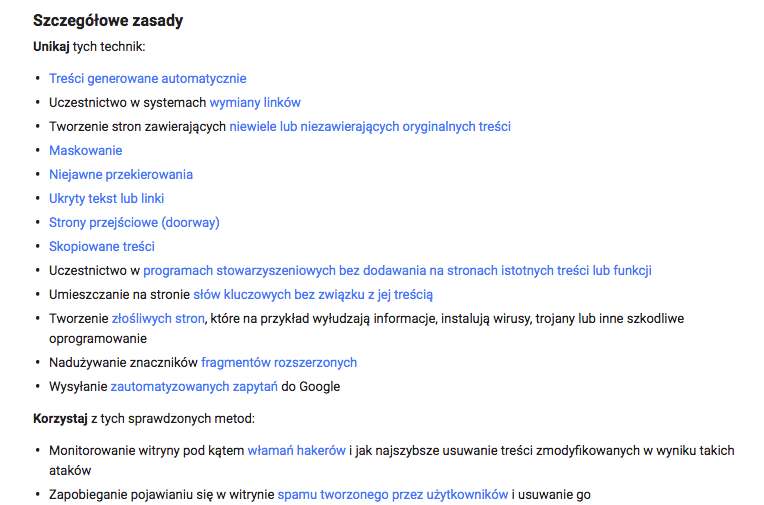
Source: https://developers.google.com/search/docs/essentials/spam-policies?hl=pl
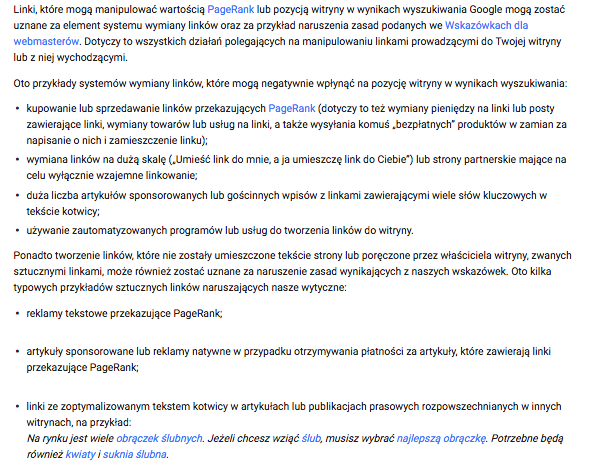
Source: https://developers.google.com/search/docs/advanced/guidelines/link-schemes
Google clearly states that if we carry out image or PR activities, sponsor an event, or publish something on someone else’s domain and thus obtain links, we should make sure that they contain the nofollow parameter. This is a marking in a page’s HTML code that has historically told bots “do not consider this link when ranking the target site.” Currently, Google applies the nofollow as a hint principle, i.e. it considers the attribute only as a hint, not a doctrinal directive. Then such a link may convey some power to the page.
Of course, by obediently following these guidelines, you reduce the potential of your website in search results, and every SEM SEO agency that knows its job will strive to acquire dofollow links – which increase Page Rank.
How to build a valuable link profile?
So we are dealing with a rather schizophrenic situation. On the one hand, we know that Google evaluates websites based on the links leading to them. On the other hand, if we obtain these links ourselves, we may be considered spammers. Google requires us to overzealously change valuable links that build the positions of our websites to ones that do not affect the algorithm. However, you must remember that the more diversified the link profile is, i.e. the more diverse they are and the more sites they come from, the more natural they look.
A natural linking profile, i.e. one that does not indicate buying links, allows you to gain Google’s trust and position yourself effectively. The key to success is diversification and maintaining the right proportions between different types of links, such as:
- external links vs. internal links (i.e. within your own website),
- nofollow vs. dofollow links,
- graphic links vs. text,
- brand links (e.g. venezia.pl) vs. links using keywords in the text of the anchor (so-called exact match – shoe shop; partial match – Venezia – shoe shop)
Below you can see an example of a report from the Ahrefs tool (used to analyze links, but also keywords):
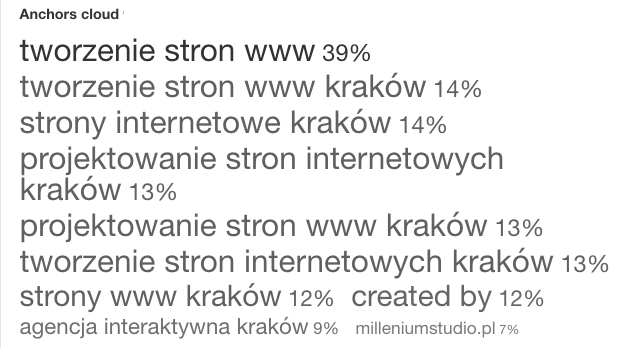
More about this case at https://www.szymonslowik.pl/linki-kary-anchor-text/
A clear predominance of links with optimized anchor text (exact match anchor-text) and a small number of branded links can be seen here. This situation significantly increases the risk of receiving a penalty, and people generally no longer use this method for SEO. It is better to build optimization for phrases using on-page factors, and use the links to convey authority from strong places (without overly intrusive use of EMA links with an optimized anchor).
Link building and valuable content
I often encounter the question – isn’t it enough to create valuable content on the website for SEO? A well-optimized website, filled with engaging, original content that responds to Internet users’ needs, is the basis, but it is not enough to achieve high positions in search results. In its advisory materials, Google suggests that creating valuable content will cause owners of other websites to link to our resources. In real life, such a scenario almost never happens and it is necessary to use paid publications.
Of course, this does not mean I discourage content creation. On the contrary! By expanding your company blog, knowledge base, publishing reports and guides, you can effectively gain traffic from the so-called long-tail – (less popular phrases, more extensive than generic keywords – e.g. how to arrange a children’s room instead of children’s furniture). However, this way it is difficult to obtain traffic directly to the most important subpages (e.g. offer pages). Moreover, in more competitive industries with extensive content creation, even long-tail SEO may be unachievable without a well-thought-out link building strategy. Thus, you should aim to have a significant number of SEO backlinks..
Let’s take a pause and summarize what you already know:
- Acquiring links leading to the website is an important factor in SEO,
- the strongest links come from websites that are well-ranked themselves – recognized by Google as valuable,
- the key to success is creating a diversified link profile,
- link building based on content marketing, publishing articles, etc. also violates Google’s guidelines for webmasters (every link building is a violation of them, we do it consciously),
- In most industries, creating valuable content has little impact on link acquisition and is usually not enough for SEO.
It’s worthwhile to explore different types of links that can either support or hinder your SEO.
Certain types of links that increase the risk of receiving a penalty
- Links from low-quality websites with many links to various websites (Google will recognize that such a domain is only used to boost the SEO of other websites and does not offer value to users).
- Site-wide links, i.e. links that appear on every subpage of a given website (e.g. in the footer, sidebar).
- Links with EMA (exact match anchor-text), whose anchor text exactly matches the keyword.
- Links from SEO directories.
Links that do not contribute to SEO
- Links from social media (they are usually nofollow; however, they can make the link profile more credible).
- The vast majority of links come from comments on forums and blogs (most CMS systems simply put a nofollow link there).
- Links from domains that are not linked themselves (such sites have zero PageRank value).
Remember that what matters to Google is the number of linking domains, not the number of links themselves. Therefore, if you can get 10 links from one domain or one link from 10 different domains, the latter scenario will usually be more advantageous.
Where to get strong SEO backlinks – examples of dofollow link sources
Link sources can be categorized by many criteria. Here are several types of places from which you can get SEO backlinks:
- thematic websites,
- local, regional and specialist media,
- bloggers’ websites,
- thematic forums (which provide dofollow links, but are well moderated and do not allow spam),
- websites of conferences, fairs and other events in which the company participates,
- websites of universities, scientific institutes,
- websites of other public institutions – offices, ministries, PARP-type websites, etc.,
- websites of non-governmental organizations.
These are merely suggestions, and in many instances (blogs, thematic websites), it may turn out that the site does not support the SEO process (either because it provides a nofollow link, or its link profile is so weak that the inflow of link equity is negligible) or is even detrimental (it emits numerous low-quality outbound links and is marked by Google as a spam source). Therefore, it is worth checking each domain individually.
How to check if a domain is a potential source of good links? I personally check the domain visibility in Senuto. If you see a suspicious drop in your chart, it could be a sign of technical issues or even a Google filter. Such a domain may not be a beneficial source of SEO backlinks. The second, key issue is the analysis of the link profile. For this purpose, for example, Ahrefs can be used and it is possible to see whether dofollow links from many other domains lead to the domain (and additionally see what the ratio of incoming links to outgoing links is). Additionally, it is worth analyzing the links that already lead to our domain. The above-mentioned Ahrefs can be used for this purpose, as well as a free tool from Google, i.e. Google Search Console. It’s not always easy to do it yourself, which is why every SEO agency should do it for you – either as part of ongoing cooperation or as a link audit.
Effective and long-term link building
We will carry out link building for you from A to Z. We will conduct a competition analysis, prepare content and acquire links that will help your website climb to the top positions in search results.
How to check if a link is safe?
Theoretically, links can be harmful. In practice, however, you would have to acquire many links from weak places to experience negative effects on your domain. Typically, Google devalues individual cases of artificial, weak, toxic links. However, in the case of a larger number of them, we may be accused of spamming.
There is no single school of thought for assessing the toxicity of links. Empirical tests are the best – placing a link to the target page with a selected keyword in the anchor text and observing whether it falls on this phrase (taking into account the behavior of other subpages and phrases in the domain). In practice, we rarely have this opportunity. Theoretically, various indicators prepared by external tools, such as Trust Flow from Majestic or link profile toxicity analysis in SEMrush, may come to help. In practice, an experienced SEO specialist should be able to assess, using several analyses, whether it is worth linking from a given place or not.
Links from the backend
It is definitely worth taking into account the potential of links that someone has already gained. How? You can capture domains on the network that have not been renewed (e.g. after completed projects, closed companies, etc.). These domains may be linked to from a number of valuable locations. The trick is to:
- capture a domain with potential,
- recreate the website on it (creating the so-called expired domains backend),
- Insert links to the website you are optimizing.
By repeating this process, we are able to create our own website directory over which we have full control.
In this case, we incur the cost of capturing the domain, setting up the website, preparing content, etc., but in return we gain a website with a strong link profile. On websites such as aftermarket.pl or premium.pl, in addition to domain capture, you can also buy domains put up for auction.
As in the case of classic link building, it is necessary to use available tools such as SEMrush or Ahrefs to examine the link profile of the domain. I do not recommend buying domains that have hundreds of suspicious linking sites and anchor texts in their profiles indicating that the domain has been heavily exploited by SEO specialists in the past (these may be various money keywords, e.g. cheap Jordan Air, buy diet pills, etc.).
Link examples
Here is an example of a branded (in this case additionally based on the URL of the home page) dofollow link from a strong domain obtained by publishing a guest post:
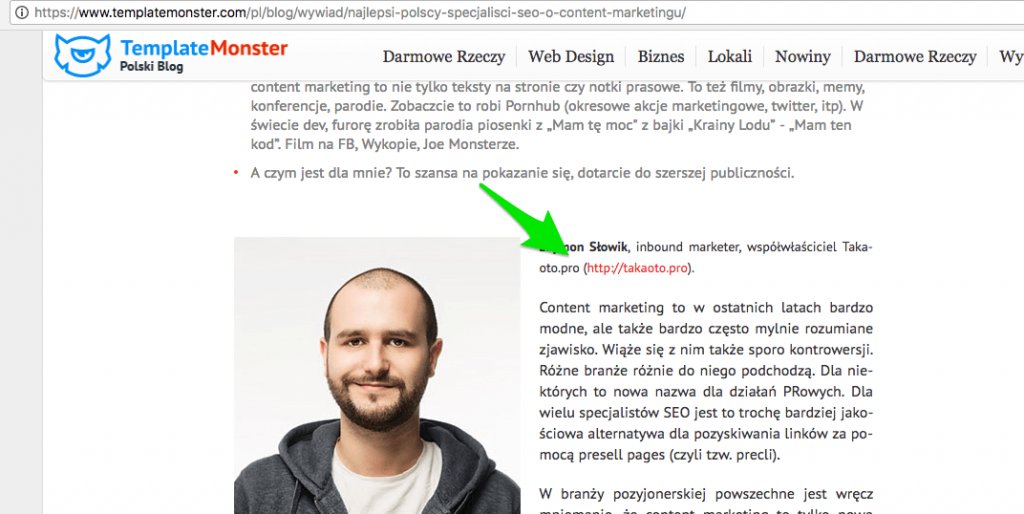
Source: https://www.templatemonster.com/pl/blog/wywiad/najlepsi-polscy-specjalisci-seo-o-content-marketingu/
An example of a natural link – someone provided a link to my post (by the way, it’s a link from the home page):
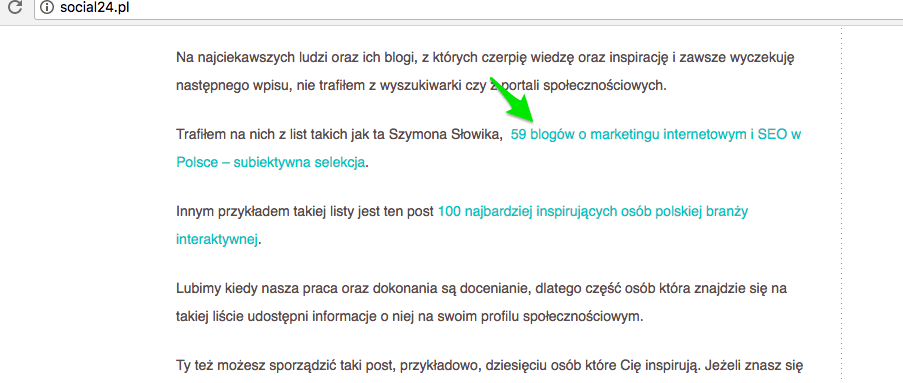
Source: http://social24.pl/
Example of a link from a Behance profile:
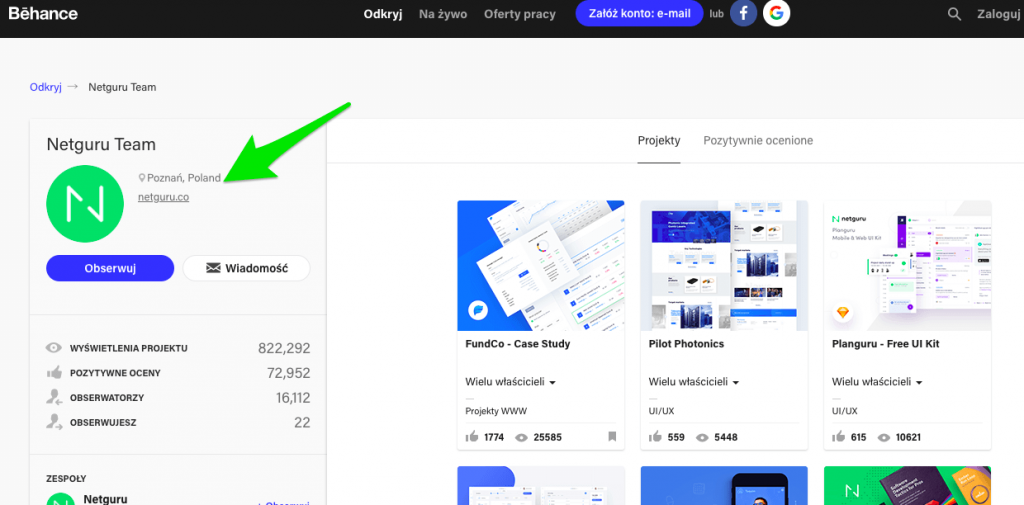
Source: behance.net/netguru
Graphic links (under logos) to partner websites on the SMSAPI.pl home page:
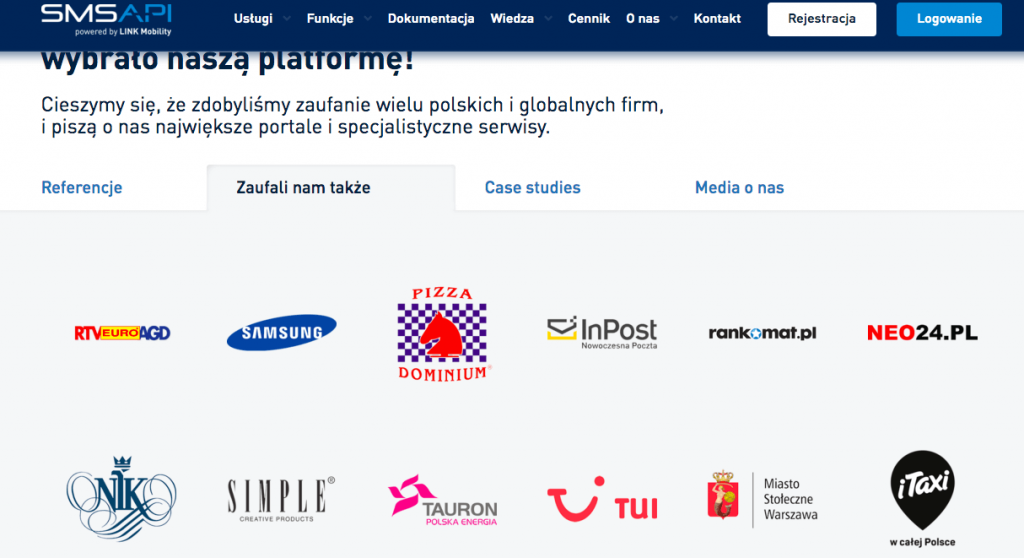
Examples of links (from the Ahrefs.com report) obtained from the websites of institutions (Zabrze City Hall, Regional Chamber of Industry and Commerce, AGH in Krakow) as a result of cooperation, participation in conferences, etc.:
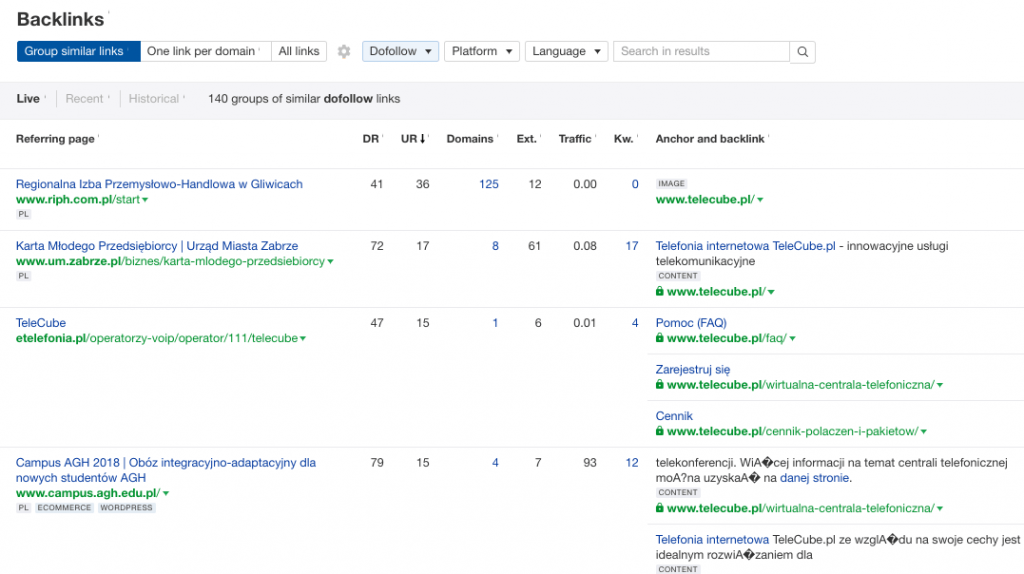
Remember that the place within the domain which the link to our website leads from is also important. The home page usually has the most impact to convey. The further a subpage is from the home page in internal linking, the less impact it is usually able to convey.
I am often asked whether links acquired through platforms such as Whitepress or Linkhouse are valuable? There is no clear answer to this question, because these websites are only intermediaries. We can use them to reach very strong websites as well as less interesting ones. We can obtain dofollow and nofollow links. Therefore, everything depends on the assessment of the specific website which we obtain the link from, and not on the website that acts as an intermediary.
Standard and non-obvious methods of acquiring links
Link building is usually based on several of the most popular tactics. It used to be cataloguing, adding links to profiles on various types of websites, or linking from forums (as they say – “randomly”, wherever you can add a dofollow link, SEO specialists worked there). Currently, people still link from forums, but the standards (at least in my opinion) should get better significantly.
Link building is changing significantly, both in terms of what the algorithm rewards in the long term and in terms of the tactics used in SEO. Links from high-quality websites, from websites with traffic, preferably thematically related to the linked website and without a large number of outgoing links are highly valuable. This model partly includes guest blogging and the so-called article marketing, i.e. content marketing, which involves publishing articles in various types of media – thematic, news, specialist websites, blogs, etc.
Of course, the devil is in the details and not every link from an article of this type is a remedy that brings top positions. The key to the matter is the ability to select domains with appropriate link parameters, traffic, information architecture and topics.
Article marketing currently constitutes a significant majority of the links we obtain at takaoto.pro. It is effective (if you know how to select domains and plan publications) and relatively easy to manage – it can be done periodically based on the budget, which suits the agency model of SEO on a subscription basis. However, this does not mean that it is not worth using other available options – the less obvious ones.
My presentation about link building from SEO Barcamp 2019 – Linkhouse’s 5th birthday
I devoted my presentation at the 5th anniversary of Linkhouse (a platform for link building based on article marketing and other forms – e.g. advertising links in the form of banners, link insertion, i.e. links in existing articles, etc.). I had the pleasure of sharing the stage with Robert Niechciał and Damian Sałkowski (they performed together) and Grzegorz Strzelec. From here I would like to warmly greet the speakers and organizers (led by Damian Kozłowski and Michał Chlewiński – great event!) and, as promised, I am sharing the presentation: Non-obvious link building tactics – presentation from SEO barcamp 2019 There is also a recording from this presentation:
Don’t let the date fool you! Although 5 years have passed since the material was presented, these methods are still valid.
I am often asked about the role of social media links. While there are various speculations that social media can positively affect SEO, there is no clear evidence in the form of websites ranked with links from social media. Obtaining traffic and building your brand in other channels is usually a positive signal. It may translate into an increase in brand traffic and an increase in CTR from Google search results. It may support direct traffic and indirectly influence the website’s visibility, but this does not mean that links from social media directly improve the website’s SEO.
This is due to the fact that links from social media such as Facebook, YouTube, X (Twitter), or LinkedIn are nofollow links. It is worth acquiring them for traffic and user engagement, but the SEO potential is extremely limited. If you run a business, it is of course worth having profiles on popular social networking sites, because this always builds brand credibility. However, for SEO purposes, it is better to seek other sources for links.
Remember that Google values links from multiple sites more than multiple links from one or more domains. Therefore, each subsequent link from site A to site B has decreasing value (I call this the marginal diminishing utility of links from a single domain – sounds smart, right? 🙂). So you won’t get many links from social media that would theoretically be important. Moreover, it is very easy for your company’s competitors to replicate it. So I don’t see much point in this regard.
You can, of course, use social media marketing to achieve link building goals, but this is material for a separate, well-planned campaign that allows you to reach e.g. bloggers or other publishers. However, this is material for a separate article or even individual considerations for each business separately. I have a short case study on this topic. If you are interested in cooperation – write to us.
Link building vs white hat SEO
There is a lot of talk in industry discussions and at marketing conferences about white hat SEO. There are suggestions that if valuable links are obtained manually from reputable websites, this is in line with Google’s guidelines. Well, no – any independent linking that aims to manipulate the algorithm and influence the ranking is inconsistent with the guidelines.
Therefore:
- every link building,
- buying or obtaining publications on content websites and thematic portals,
- asking for dofollow links,
- advertising cooperation with bloggers,
- bartering
…all of this violates Google’s guidelines.
The only thing that complies with the guidelines is to create valuable content that other publishers spontaneously link to. However, this is so rare in practice that a website taking such measures has a very low chance of reaching top positions in Google. If I were to define what white hat link building is, I would say that it is simply the promotion of content, which translates into voluntary (i.e. not conditioned by e.g. competition regulations, etc.) placing links to our website by network users (bloggers, publishers, editors, other companies).
Broken links
One of the noteworthy link acquisition tactics is searching for broken links. In the case of domains with a history or brands that have been on the market for a long time, there is a suspicion that a number of links to the website have appeared on the Internet, but they are damaged – e.g. due to a typo in the address. If the domain in the href field in the link is correct, Ahrefs will detect such a broken link. In the panel you will find a separate report with a list of this type of links. This allows you to contact publishers and ask them to insert the correct URL. A link leading to a page with a status of 200 (correctly displayed page) will build the authority of your website (unlike a link leading to a URL with a server response status of 404: not found).
Help in acquiring links, link building services
Are you looking for support in the process of building a valuable link profile? Do you need consultation or verification of the current link profile leading to your domain? Opt for SEO services and a comprehensive SEO audit!


